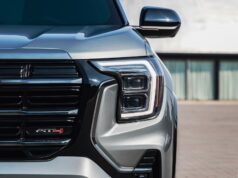Tesla already offers its self-driving Autopilot technology, but Cadillac says it plans to take the technology a few steps further this fall. The 2018 Cadillac CT6 is going to be offered with Cadillac’s new Super Cruise self-driving system that offers two features that Tesla does not – driver attention monitoring and precision LiDAR map data.
Super Cruise adds automatic lane-centering to CT6’s existing list of driver assistance active safety technologies, enabling automatic control of speed and steering during highway driving.
According to Cadillac, Super Cruise is the “industry’s first true hands-free driving technology for the highway.” Cadillac’s new driver monitoring system supports safer operation than other driving assistance systems that are already offered. The driver attention system uses a small camera located on the top of the steering column that focuses only on the driver and works with infrared lights to track head position to determine where the driver is looking whenever Super Cruise is in operation.
If the system detects the driver has turned attention away from the road ahead for too long, it will prompt the driver to return their attention to the road ahead, while continuing to steer. If the driver still isn’t paying attention, the steering wheel light bar guides the driver to look at the road or take back control of the wheel. Additional alerts can include visual indicators in the instrument cluster, tactile alerts in Cadillac’s Safety Alert Seat and audible alerts.
Related: Cadillac to launch a compact crossover in 2018
In an unfortunate circumstance where the driver becomes unresponsive, Super Cruise can bring the Cadillac CT6 can bring to a controlled stop and contact OnStar to alert first responders.
Super Cruise is the first assisted driving technology that will use LiDAR map data in addition to real-time cameras, sensors and GPS. Super Cruise adds to this formula using advanced laser technology in development for future autonomous vehicles: a LiDAR-scanned map database.
Combined with the real-time data from cameras and GPS sensors, the precision map governs system use, enabling it in only the areas where appropriate road conditions are detected. The combination of real-time data with precision mapping also improves vehicle control through curves and hills.
“American drivers travel twice as many miles on urban and suburban highways as they do on rural roads,” said Barry Walkup, chief engineer of Cadillac Super Cruise. “Super Cruise™ allows hands-free driving and operates only within the environment where it has the most benefit. While it is technically possible for the technology to drive hands-free on other kinds of streets and roads, we feel strongly that this targeted approach is the best to build consumer and regulatory confidence and enthusiasm for advanced mobility.
Source: Cadillac












